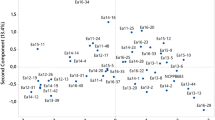Abstract
A collection of 205 strains ofErwinia amylovora isolated in Israel over a period of 12 years has been established. The strains were isolated from different varieties of pear, apple, loquat and quince grown in Israel, and collected from different locations in the country. They were characterized in respect to degree of virulence on several hosts and serological and molecular characters. Pathogenicity tests carried out on flowering branches of pear and apple, shoots of pears, and on trees of pear and loquat grown in containers outdoors, revealed no significant differences in the severity of blossom blight or shoot blight among the various strains. ELISA and immunofluorescence assays revealed no serotypic groups among the Israeli strains. Genomic diversity was studied by random amplified polymorphic DNA (RAPD) analysis using 24 arbitrary 10-base primers. All the strains examined (45 Israeli and 11 from Egypt, Cyprus and Greece) produced the same RAPD patterns with each of the primers used. Amplification patterns were indistinguishable from those produced by strains isolated from the neighboring countries. Results presented in this study suggest that the population ofE. amylovora in Israel is homogenous.
Similar content being viewed by others
References
Ausubel, F.M., Brent, R., Kingston, R.E., Moore, D., Seidman, J.G., Smith, J.A. and Struhl, K. [Eds.] (1989) Short Protocols in Molecular Biology. Greene Publishing Associates and Wiley-Interscience, New York, NY.
Beer, S.V. and Rundle, J.R. (1983) Suppression ofErwinia amylovora byErwinia herbicola in immature pear fruits.Phytopathology 73:1346 (abstr.).
Beer, S.V., Shabi, E. and Zutra, D. (1986) Fire blight in Israel — 1985. Observations and recommendations.EPPO Bull. 16:639–646.
Bereswill, S., Pahl, A., Bellemann, P., Zeller, W. and Geider, K. (1992) Sensitive and species-specific detection ofErwinia amylovora by polymerase chain reaction.Appl. Environ. Microbiol. 58:3522–3526.
Falkenstein, H., Bellemann, P., Walter, S., Zeller, W. and Geider, K. (1988) Identification ofE. amylovora, the fireblight pathogen, by colony hybridization with DNA from plasmid pEA29.Appl. Environ. Microbiol. 54:2798–2802.
Goodman, R.N. (1973) Variation inErwinia amylovora with respect to virulence.2nd Int. Congr. Plant Pathology p. 934 (abstr.).
Ishimaru, C. and Klos, E.J. (1984) A new medium for detectingErwinia amylovora and its use in epidemiological studies.Phytopathology 74:1342–1345.
Kemeny, D.M. and Challacombe, S.J. (1988) ELISA and other solid phase immunoassays. John Wiley and Sons, New York, NY.
Laurent, J., Barny, M.-A., Kotoujansky, A., Dufriche, P. and Vanneste, J.L. (1989) Characterization of a ubiquitous plasmid inErwinia amylovora.Mol. Plant Microbe Interac. 2:160–164.
Lin, C.P., Chen, T.A., Wells, J.M. and Van derZwet, T. (1987) Identification and detection ofErwinia amylovora with monoclonal antibodies.Phytopathology 77:376–380.
Maes, M., Garbeva, P. and Crepel, C. (1996) Identification and sensitive endophylic detection of the fire blight pathogenErwinia amylovora with 23S ribosomal DNA sequences and the polymerase chain reaction.Plant Pathol. 45:1139–1149.
McKinney, R.M. and Cherry, W.B. (1985) Immunofluorescence Microscopy, pp. 891–896.in: Lennnette, E.H. [Ed.] Manual of Clinical Microbiology. 4th ed. American Society for Microbiology, Washington, DC.
McManus, P.S. and Jones, A.L. (1995) Genetic fingerprinting ofErwinia amylovora strains isolated from tree-fruit crops andRubus spp.Phytopathology 85:1547–1533.
Miller, T.D. and Schroth, M.N. (1972) Monitoring the epiphytic population ofErwinia amylovora on pear with selective medium.Phytopathology 62:1175–1182.
Norelli, J.L., Aldwinckle, H.S. and Beer, S.V. (1984) Differential host-pathogen interactions among cultivars of apple and strains ofErwinia amylovora.Phytopathology 74:136–139.
Quamme, H.A. and Bonn, W.G. (1982) Virulence ofErwinia amylovora and its influence on the determination of fire blight resistance to pear cultivars and seedlings by artificial inoculation.Can. J. Plant Pathol. 3:187–190.
Roberts, P. (1980) Problems encountered during immunofluorescence diagnosis of fireblight.Plant Pathol. 29:93–97.
Shabi, E. and Zutra, D. (1987) Outbreaks of fire blight in Israel in 1985 and 1986.Acta Hortic. 217:23–31.
Shabi, E. and Zutra, D. (1989) Five years of fire blight in Israel.Acta Hortic. 273:41 (abstr.).
Shaffer, W.H. and Goodman, R.H. (1962) Progressionin vivo, rate of growthin vitro, and resistance to streptomycin, as indices of virulence ofErwinia amylovora.Phytopathology 52:1201–1207.
Van derZwet, T. (1996) Present worldwide distribution of fire blight.Acta Hortic. 411:7–8.
Van der Zwet, T. and Keil, H.L. (1979) Fire blight. A bacterial disease of rosaceous plants.U.S. Dep. Agric. Agric. Handb. 510.
Vantomme, R., Swings, J., Goor, M., Kersters, K. and De Ley, J. (1982) Phytopathological, serological, biochemical and protein electrophoretic characterization ofErwinia amylovora strains isolated in Belgium.Phytopathol. Z. 103:349–360.
Zilberstaine, M., Herzog, Z., Manulis, S. and Zutra, D. (1996) Outbreak of fire blight threatening the loquat industry in Israel.Acta Hortic. 411:177–178.
Zutra, D., Shabi, E. and Lazarovits, G. (1986) Fire blight on pear, a new disease in Israel.Plant Dis. 70:1071–1073.
Author information
Authors and Affiliations
Corresponding author
Rights and permissions
About this article
Cite this article
Manulis, S., Kleitman, F., Dror, O. et al. Characterization of theErwinia amylovora population in Israel. Phytoparasitica 26, 39–46 (1998). https://doi.org/10.1007/BF02981264
Received:
Revised:
Issue Date:
DOI: https://doi.org/10.1007/BF02981264




